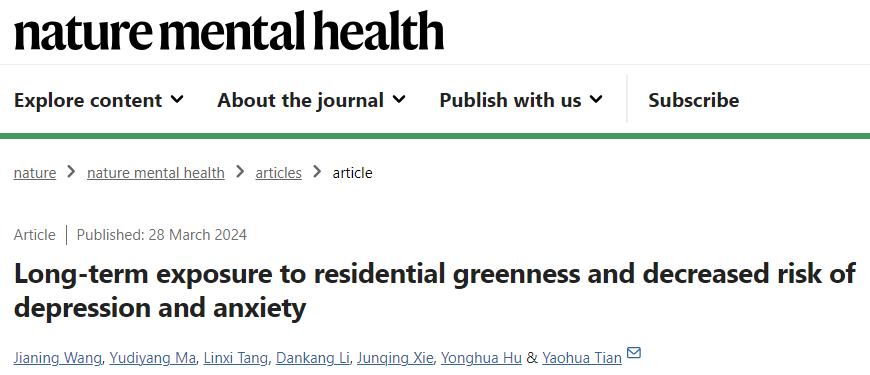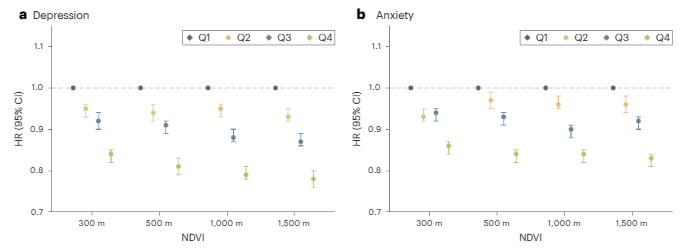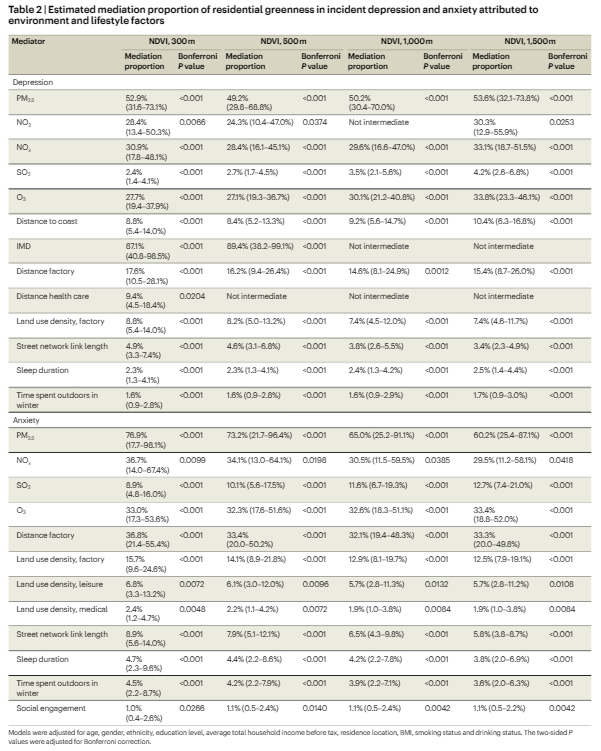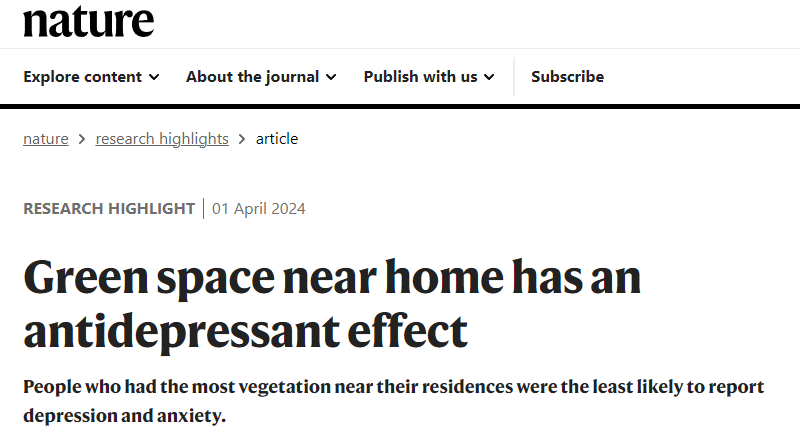The team of Prof. Yaohua Tian reveals the role of green spaces in alleviating depression and anxiety
Depression and anxiety disorders, which often coexist, represent the two most prevalent and disabling mental disorders affecting 280 million and 301 million people worldwide respectively. How to improve mental health and reduce the burden of mental illness has become an urgent issue, both for individuals and society as a whole.
Recently, a study by the Tian Yaohua team from the School of Public Health at Huazhong University of Science and Technology, published in Nature Mental Health, indicated that long-term residential greenness can reduce the risk of developing depression and anxiety disorders. This research also suggested that reduced air pollution was a significant mediator connecting green environments to depression and anxiety. Jianing Wang, a graduate student from the School of Public Health, was the first author, and Prof. Yaohua Tian was the corresponding author.

We analyzed data in 409,556 participants from the UK Biobank. Residential greenness was assessed using the Normalized Difference Vegetation Index (NDVI) within a buffer region of 300-m, 500-m, 1000-m, and 1500-m. The NDVI values range from -1 to 1, with higher values indicating a greater extent of greenness. Incident depression and anxiety cases were determined by linking to data on hospital admissions, death register, primary care, and self-report.
During a median follow-up of 11.9 years, 14,309 (3.5%, 306.9/100,000 person-years) and 16,692 (4.1%, 358.0/100,000 person-years) patients were diagnosed with depression and anxiety, respectively. The hazard ratios (HRs) and 95% confidence intervals (CIs) for depression and anxiety were 0.84 (95% CI, 0.82-0.85; P < 0.001) and 0.86 (95% CI, 0.84-0.87; P < 0.001) in the highest quartile compared with the lowest quartile of NDVI 300-m, respectively. Similar trends were shown for NDVI 500-m, 1000-m, and 1500-m.

Figure 1. Association of Normalized Difference Vegetation Index with incident depression and anxiety.
Notably, mechanisms underlying the health effects of greenness are not fully understood, but several hypotheses have been proposed from three domains: providing environmental benefits (e.g. reducing air pollution and noise), building capacities (e.g. facilitating physical activity and social cohesion), and restoring capacities (e.g. attention and stress restoration).
We have also explored a series of variables as potential mediators, including the physical environment (air pollutants, noise, water percentage, distance to education/factory/healthcare/transport/coast places, density of agricultural/leisure/education/factory/medical/transport/residential places, and street network accessibility), social environment (socioeconomic indices of multiple deprivation), and lifestyle (physical activity, social engagement, sleep, electronic device use, and time spend outdoors in summer/winter). The results of mediation analyses suggested that air pollution played a major mediator role in the associations of NDVI within all studied buffers with both depression and anxiety. Specifically, the association between NDVI 300-m and depression was 52.9% (95%CI, 31.6%-73.1%), 28.4% (95%CI, 13.4%-50.3%), 30.9% (95%CI, 17.8%-48.1%), 2.4% (95%CI, 1.4%-4.1%), and 27.7% (95%CI, 19.4%-37.9%) mediated by the decreased particulate matter with an aerodynamic diameter of 2.5 μm or less (PM2.5), nitrogen dioxide (NO2), nitrogen oxides (NOx), sulfur dioxide (SO2), and ozone (O3), respectively; the association between NDVI 300-m and anxiety was 76.9% (95%CI, 17.7%-98.1%), 36.7% (95%CI, 14.0%-67.4%), 8.9% (95%CI, 4.8%-16.0%), and 33.0% (95%CI, 17.3%-53.6%) mediated by the decreased PM2.5, NOx, SO2, and O3, respectively.
Table 1. Estimated mediation proportion of residential greenness in incident depression and anxiety attributed to environment and lifestyle factors.

In conclusion, the study indicated that long-term exposure to residential greenness was associated with decreased risk of incident depression and anxiety. These findings have important policy implications, suggesting that local governments can strengthen greenness through strategic planning measures, which can serve as actionable public health and urban planning interventions to facilitate the promotion of mental well-being. The research findings were concurrently highlighted by Nature as a research highlight.

Figure 2. Nature Research Highlight

